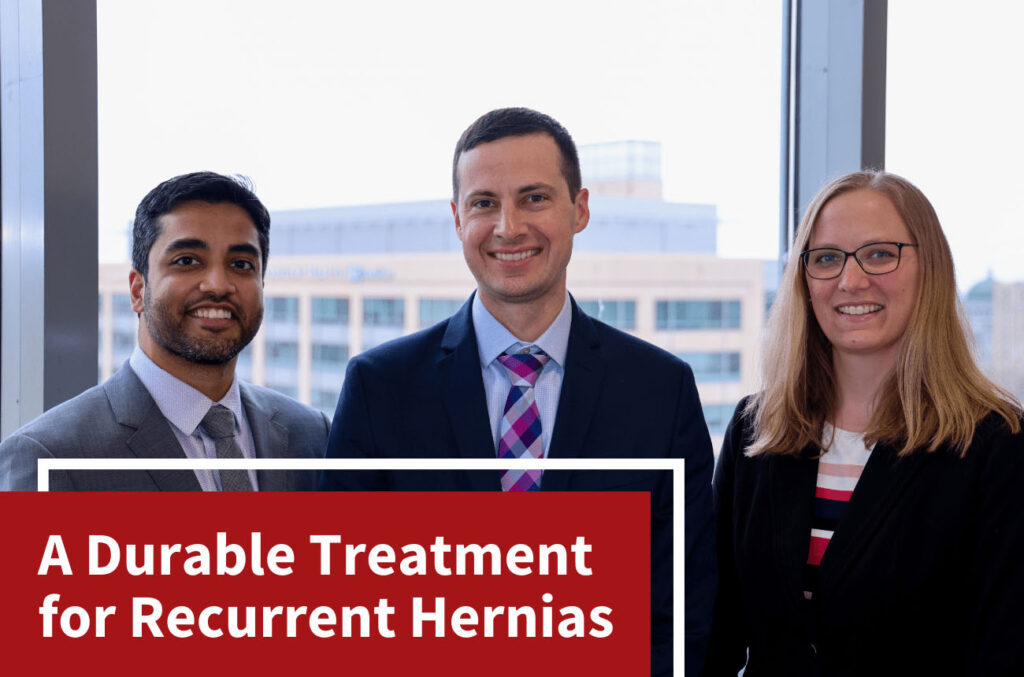For a person with a bulging, painful hernia, surgery can be life changing. Hernia repair typically provides a long-lasting solution. In some cases, however, a recurrent hernia may appear at or near the location of the previous hernia. Scar tissue, existing mesh from past surgeries and other factors make recurrent hernias more challenging to treat. Each time a hernia recurs, it is more complex to repair than before.
A recent study by Washington University hernia surgeons and general surgery residents utilized a promising approach with successful long-term outcomes for patients with complex ventral hernias.
The findings are published in the journal Surgery.
“We see a lot of patients who are on a vicious cycle of recurrent hernias,” says Jeffrey Blatnik, MD, an associate professor of surgery and the study’s senior author. “Data shows us that when people have one recurrence, they are at higher risk of having another recurrence. To find a good solution to break that cycle of recurrent hernias is critical to keep people out of the operating room.”
In the study, investigators reviewed the charts of more than 130 patients who underwent recurrent ventral hernia repair using the technique, called transversus abdominis release, at Washington University School of Medicine in St. Louis. Transversus abdominis release is a type of procedure that entails separating the layers of the abdominal wall to allow a more tension-free repair and better overlap for mesh placement, even if the patient has had previous hernia repairs. The results of this procedure tend to be durable and long-lasting, meaning most patients do not experience recurrent ventral hernias at the site of surgery.
“The ability to apply this technique to multiple different scenarios—for people who have had previous repairs or for people with hernias around stomas, for example—makes transversus abdominis release a robust treatment option,” says Blatnik. “For patients who have had previous failed hernia repairs, transversus abdominis release allows us to operate in a different layer of the abdominal wall, where they typically have not had prior surgeries.”
The cases in this study included both open and robotic surgical approaches. Up to 15 months after surgery, only five percent of patients had hernia recurrence.
“Our ability as a high-volume institution is unique because we have the privilege of caring for a high volume of patients with very complex recurrent hernias, which allows for us to conduct research and advance our knowledge of optimal hernia repairs available for these patients,” says first author Britta Han, MD, MSEd, a general surgery resident at the School of Medicine.
Washington University hernia surgeons specialize in minimally invasive surgical techniques, including laparoscopic and robotic hernia repair. These procedures involve smaller incisions than traditional open surgery, and typically result in less pain and shorter hospital stays. When open surgery is indicated, Washington University hernia surgeons have the expertise to provide comprehensive care throughout the surgical journey.
“One of the things that makes hernia care at WashU unique is that every surgeon on our team has completed advanced fellowship training in the latest techniques, giving us a large toolkit to address different types of hernias,” says Arnab Majumder, MD, an assistant professor of surgery.
“With these various techniques, we offer personalized hernia care,” says Sara Holden, MD, an assistant professor of surgery. “Not every hernia that we see is treated the same in all patients. From the preoperative care to postoperative follow-up, we see our patients as individuals. We know that they may have different goals for surgery. We help them prepare for surgery, discuss different surgical techniques, and carefully manage their postoperative course to ensure the smoothest recovery with the best results.”
While recurrent hernias are challenging, there are some steps a person can take to prevent them from happening. Quitting smoking has been proven to improve surgical outcomes and is especially important for wound healing after hernia surgery. Maintaining a healthy weight is another way to reduce the risk of hernia repair failure. Blatnik, Holden and Majumder help their patients get access to the resources they need to improve their health before and after surgery.
The next step in this ongoing research will be to continue follow-ups with patients and study the durability of transversus abdominis release over a longer timeframe. This large, single-institution study suggests the procedure may reduce postoperative complications and hernia recurrence, which could greatly improve the quality of life for people who have experienced the pain of abdominal wall hernias.
